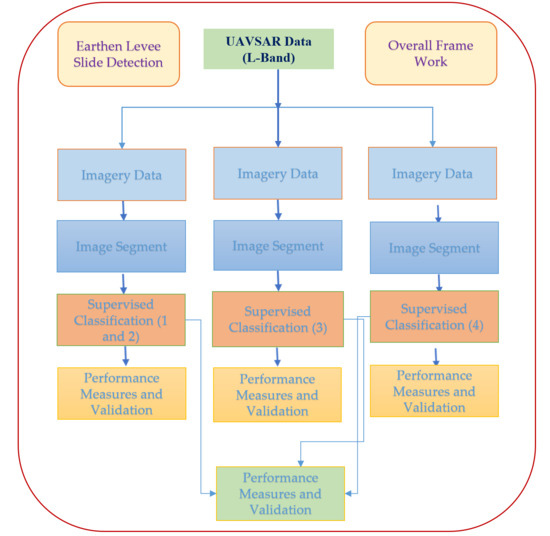Accuracy Analysis Comparison of Supervised Classification Methods for Anomaly Detection on Levees Using SAR Imagery
Abstract
:1. Introduction
2. Materials and Methods
2.1. Data Description
2.2. Methods
2.2.1. Minimum Distance Using Euclidean Distance
- D = Euclidean distance
- i = the ith class
- x = n-dimensional data (where n is the number of features)
- mi = mean vector of a class
2.2.2. Minimum Distance Using Mahalanobis Distance
- D = Mahalanobis distance
- i = the ith class
- x = n-dimensional data (where n is the number of features)
- Σ−1 = the inverse of the covariance matrix of a class
- = mean vector of a class
2.2.3. Support Vector Machine
2.2.4. Maximum Likelihood
- i = the ith class
- x = n-dimensional data (where n is the number of features)
- p(ωi) = probability that a class occurs in the image and is assumed the same for all classes
- |Σi| = determinant of the covariance matrix of the data in a class
- Σi−1 = the inverse of the covariance matrix of a class
3. Results and Discussion
4. Conclusions
Acknowledgments
Author Contributions
Conflicts of Interest
References
- Aanstoos, J.V.; Hasan, K.; O’Hara, C.G.; Prasad, S.; Dabbiru, L.; Mahrooghy, M.; Nobrega, R.; Lee, M.L.; Shrestha, B. Use of Remote Sensing to Screen Earthen Levees. In Proceedings of the 39th IEEE Applied Imagery Pattern Recognition Workshop, Washington, DC, USA, 13–15 October 2010; pp. 1–6. [Google Scholar]
- Dunbar, J. USACE’s lower Mississippi valley engineering geology and geomorphology mapping program for levees. In Presentation at Vicksburg; USACE: Vicksburg, MS, USA, 16 April 2009. [Google Scholar]
- Aanstoos, J.V.; Hasan, K.; O’Hara, C.; Prasad, S.; Dabbiru, L.; Mahrooghy, M.; Gokaraju, B.; Lee, M.; Nobrega, R.A.A. Earthen Levee Monitoring with Synthetic Aperture Radar. In Proceedings of the 2011 IEEE Applied Imagery Pattern Recognition Workshop (AIPR), Washington, DC, USA, 11–13 October 2011. [Google Scholar]
- Hossain, A.K.M.A.; Easson, G.; Hasan, K. Detection of Levee Slides Using Commercially Available Remotely Sensed Data. Environ. Eng. Geosci. 2006, 12, 235–246. [Google Scholar] [CrossRef]
- MS Levee Board. Available online: http://www.msleveeboard.com/index.php/about/history (accessed on 3 July 2017).
- Knoeff, H.; Vastenburg, W.E. Automated Engineering in Levee Risk Management. In Proceedings of the 3rd International Symposium on Geotechnical Safety and Risk, Munich, Germany, 2–3 June 2011. [Google Scholar]
- USACE. 2012. National Levee Database-Home. Available online: http://nld.usace.army.mil/egis/f?p=471:1 (accessed on 4 July 2017).
- The Mississippi River & Tributaries Project: Levee System Evaluation Report for the National Flood Insurance Program. April 2014. Available online: http://www.mvd.usace.army.mil/Portals/52/docs/MRC/LeveeSystem/MRT_levee_system_eval_report_for_NFIP.pdf (accessed on 7 October 2017).
- Kong, J.A.; Yueh, S.H.; Lim, H.H.; Shin, R.T.; van Zyl, J.J. Classification of earth terrain using polarimetric synthetic aperture radar images. Progress Electromagn. Res. 1990, 3, 327–370. [Google Scholar]
- Pottier, E.; Lee, J.-S.; Ferro-Famil, L. PolSARpro 4.2 (Polsarpro is a Polarimetric SAR Data Processing and Educational Tool). Available online: http://polsarpro.software.informer.com/4.2/ (accessed on 7 October 2017).
- Marapareddy, R.; Aanstoos, J.V.; Younan, N.H. A Supervised Classification Method for Levee Slide Detection using Complex Synthetic Aperture Radar Imagery. J. Imaging 2016, 2, 26. [Google Scholar] [CrossRef]
- Aanstoos, J.V. Levee Assessment via Remote Sensing; SERRI Report 80023-02; Southeast Region Research Initiative: Oak Ridge, TN, USA, 2012. [Google Scholar]
- Aanstoos, J.V.; Hasan, K.; O’Hara, C.; Dabbiru, L.; Mahrooghy, M.; Nobrega, R.A.A.; Lee, M.M. Detection of Slump Slides on Earthen Levees Using Polarimetric SAR Imagery. In Proceedings of the 2012 IEEE Applied Imagery Pattern Recognition Workshop, Washington, DC, USA, 9–11 October 2012. [Google Scholar]
- Uninhabited Aerial Vehicle Synthetic Aperture Radar. Available online: http://www.jpl.nasa.gov/missions/index.cfm?mission=UAVSAR (accessed on 10 July 2017).
- ENVI Version 5.1. Exelis Visual Information Solutions User Guides and Tutorials. Available online: http://www.exelisvis.com/Learn/Resources/Tutorials.aspx (accessed on 15 July 2017).
- Soliman, O.S.; Mahmoud, A.S. A classification system for remote sensing satellite images using support vector machine with non-linear kernel functions. In Proceedings of the 8th International Conference on Informatics and Systems (INFOS), Cairo, Egypt, 14–16 May 2012; pp. 181–187. [Google Scholar]
- Kaya, G.T.; Ersoy, O.K.; Kamasak, M.E. Support Vector Selection and Adaptation for Remote Sensing Classification. IEEE Trans. Geosci. Remote Sens. 2011, 49, 2071–2079. [Google Scholar] [CrossRef]
- Morton, J.C. Image Analysis, Classification and Change Detection in Remote Sensing: With Algorithms for ENVI/IDL and Python 2014, 3rd ed.; CRC Press: Boca Raton, FL, USA, 2014; pp. 1–576. ISBN 9781466570375. [Google Scholar]
- Hsu, C.-W.; Chang, C.-C.; Lin, C.-J. A Practical Guide to Support Vector Classification. National Taiwan University, 2010. Available online: http://ntu.csie.org/~cjlin/papers/guide/guide.pdf (accessed on 15 July 2017).
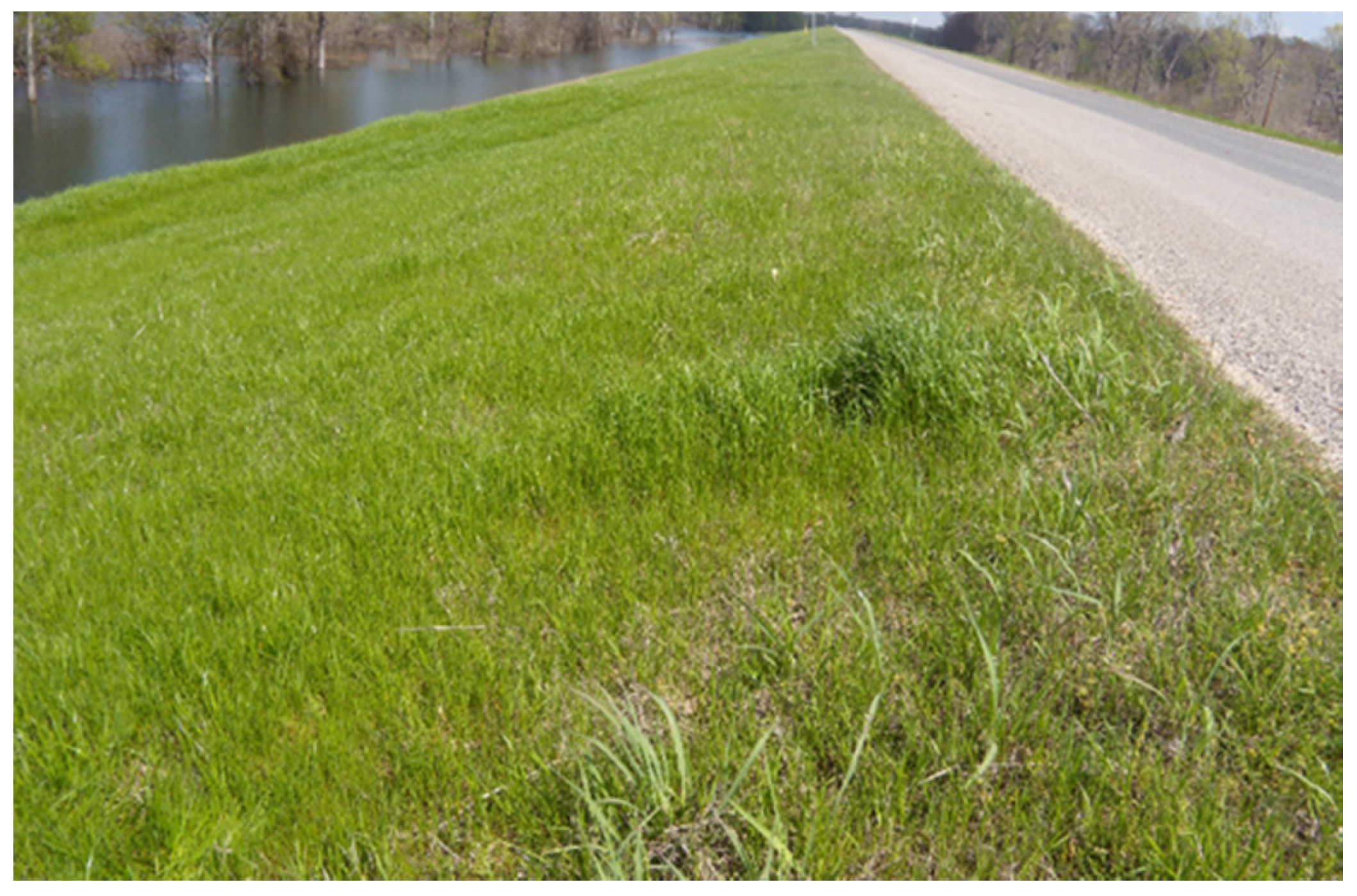

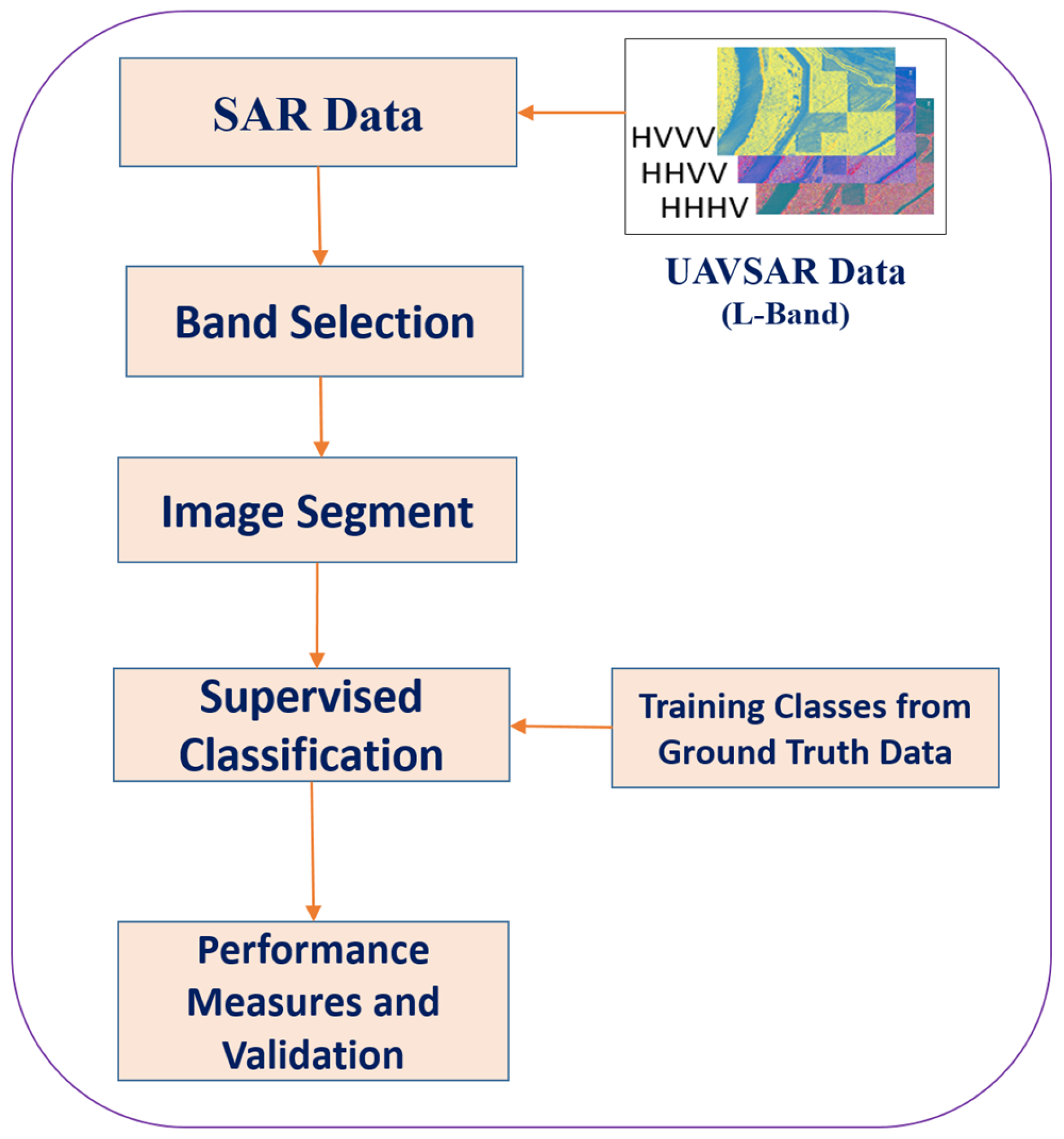
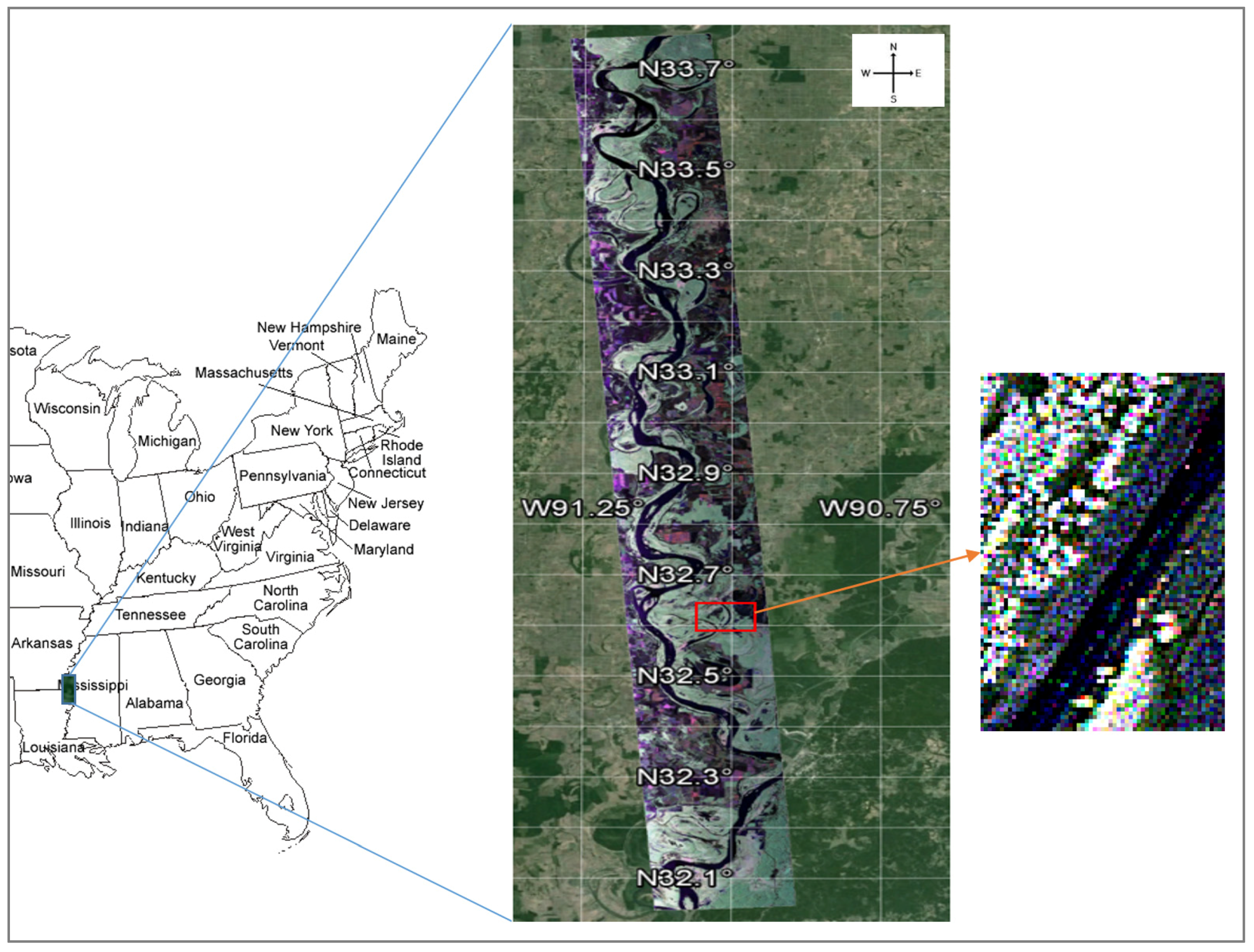
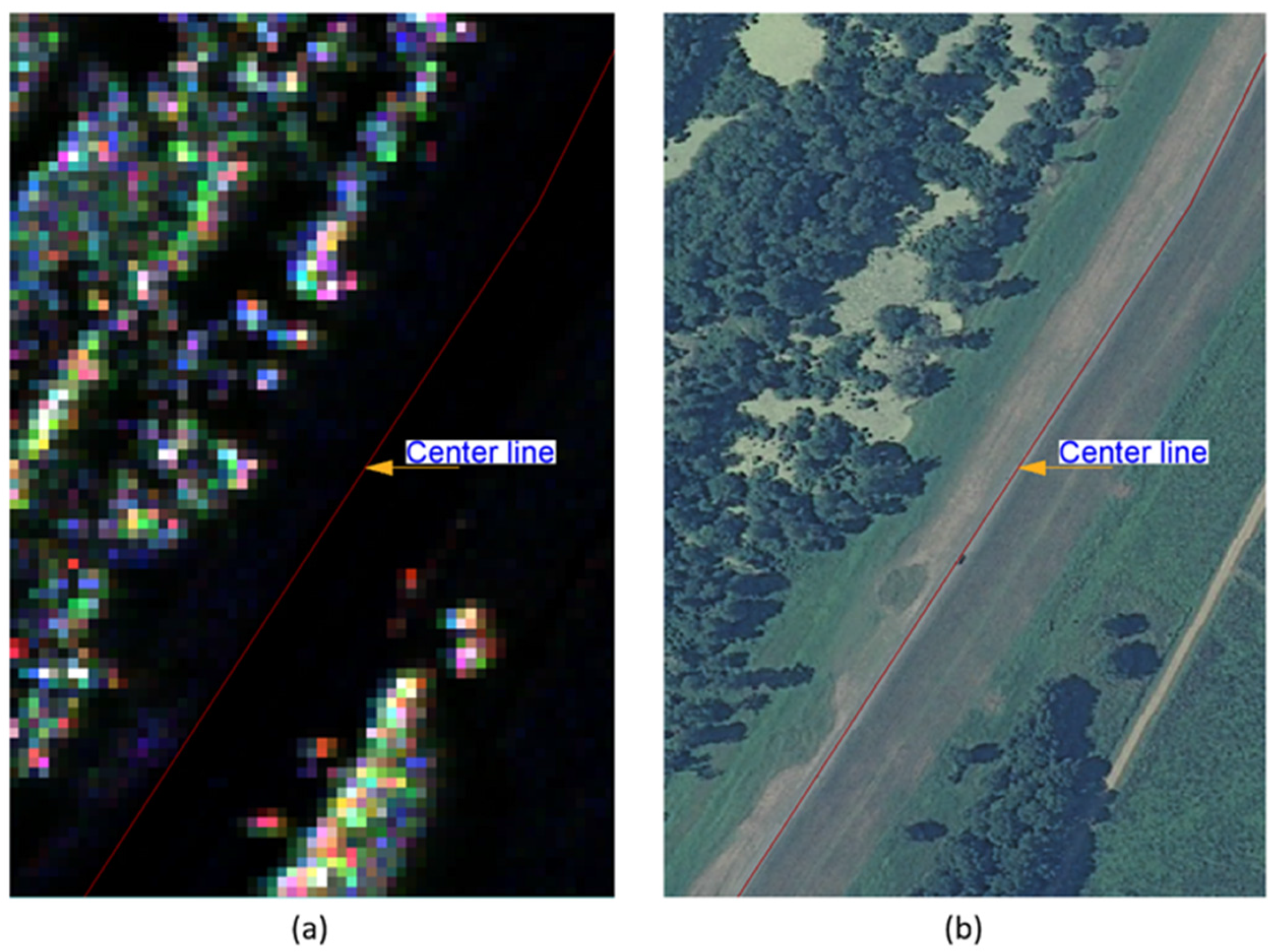
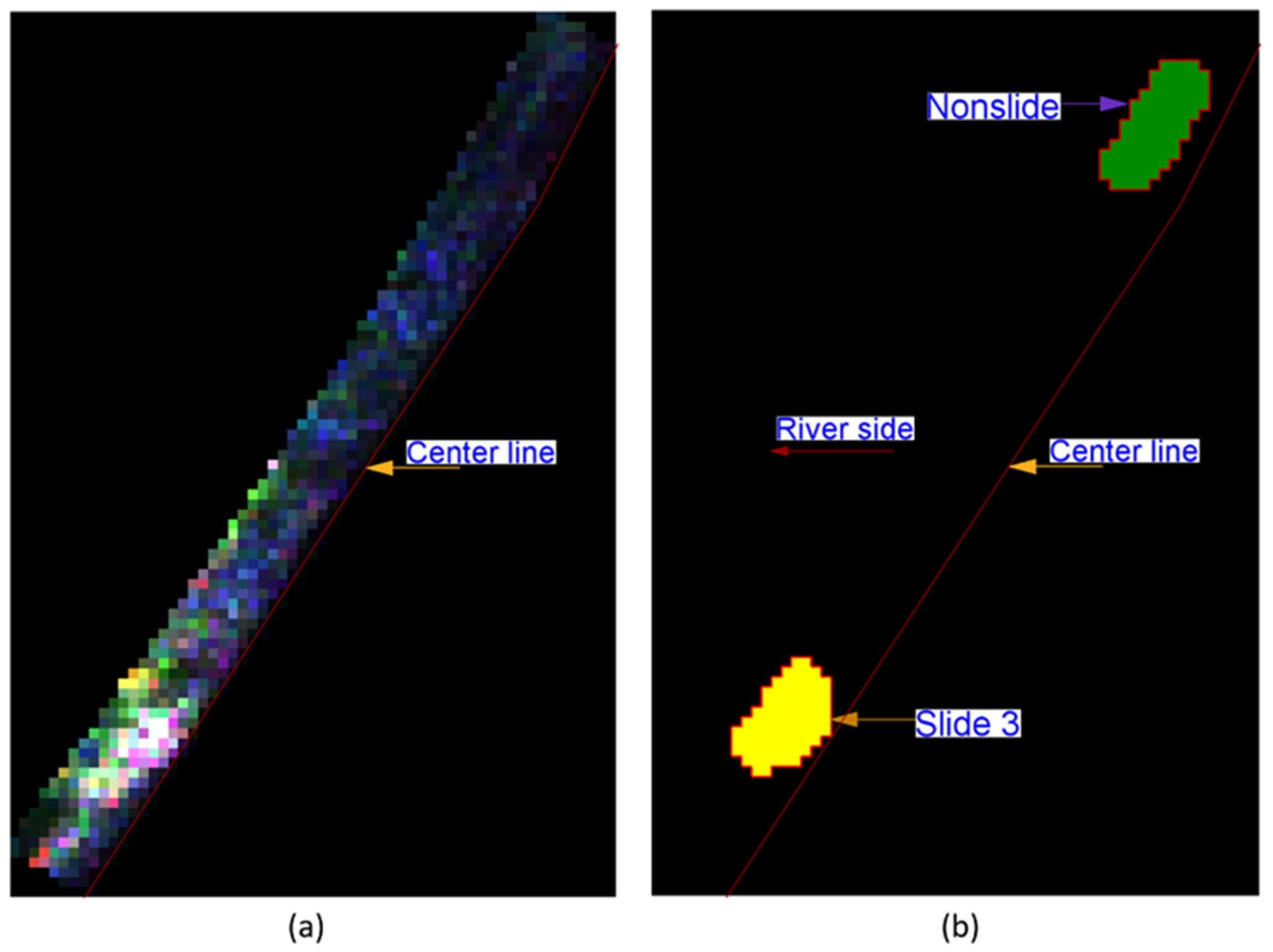
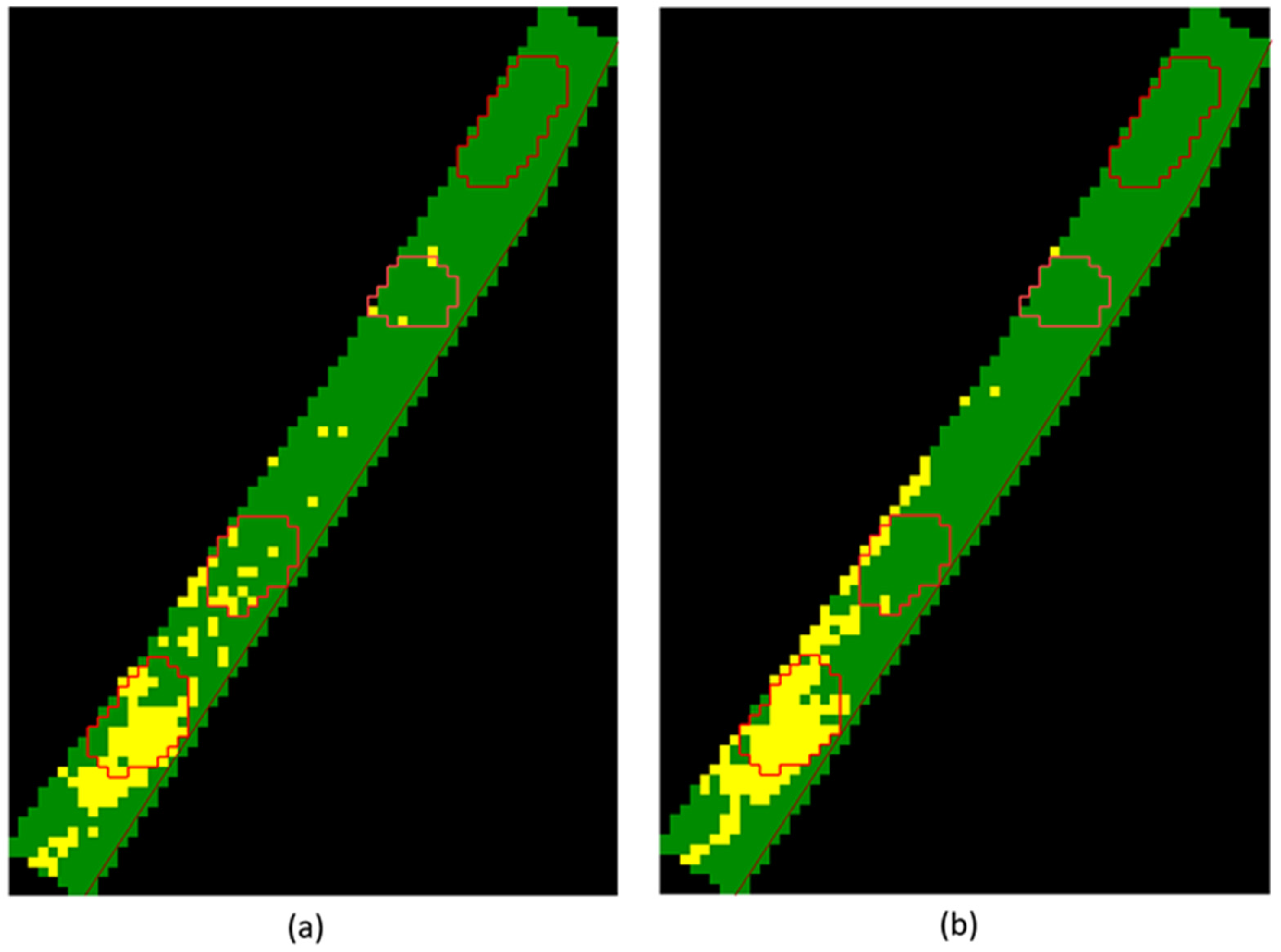
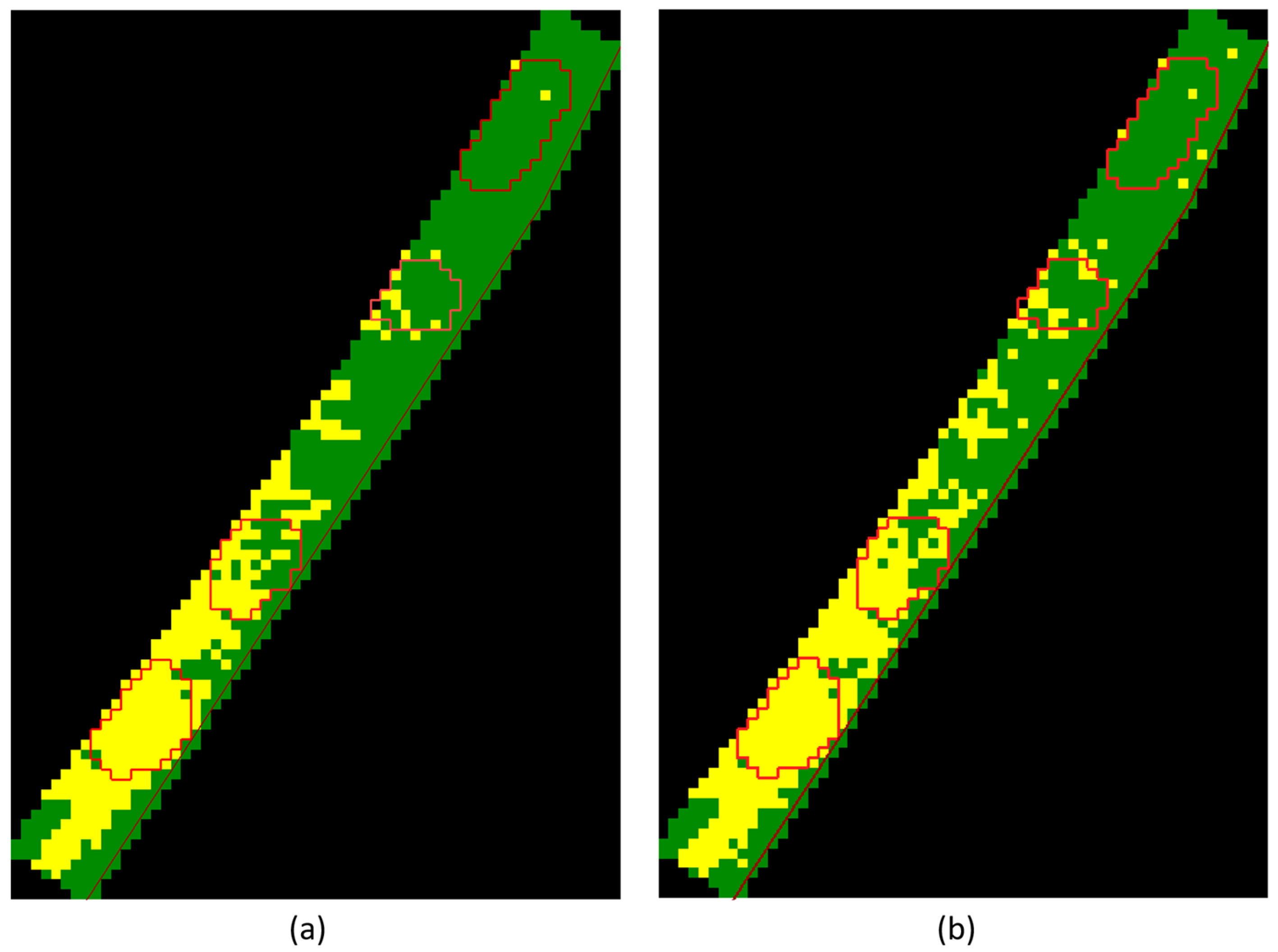
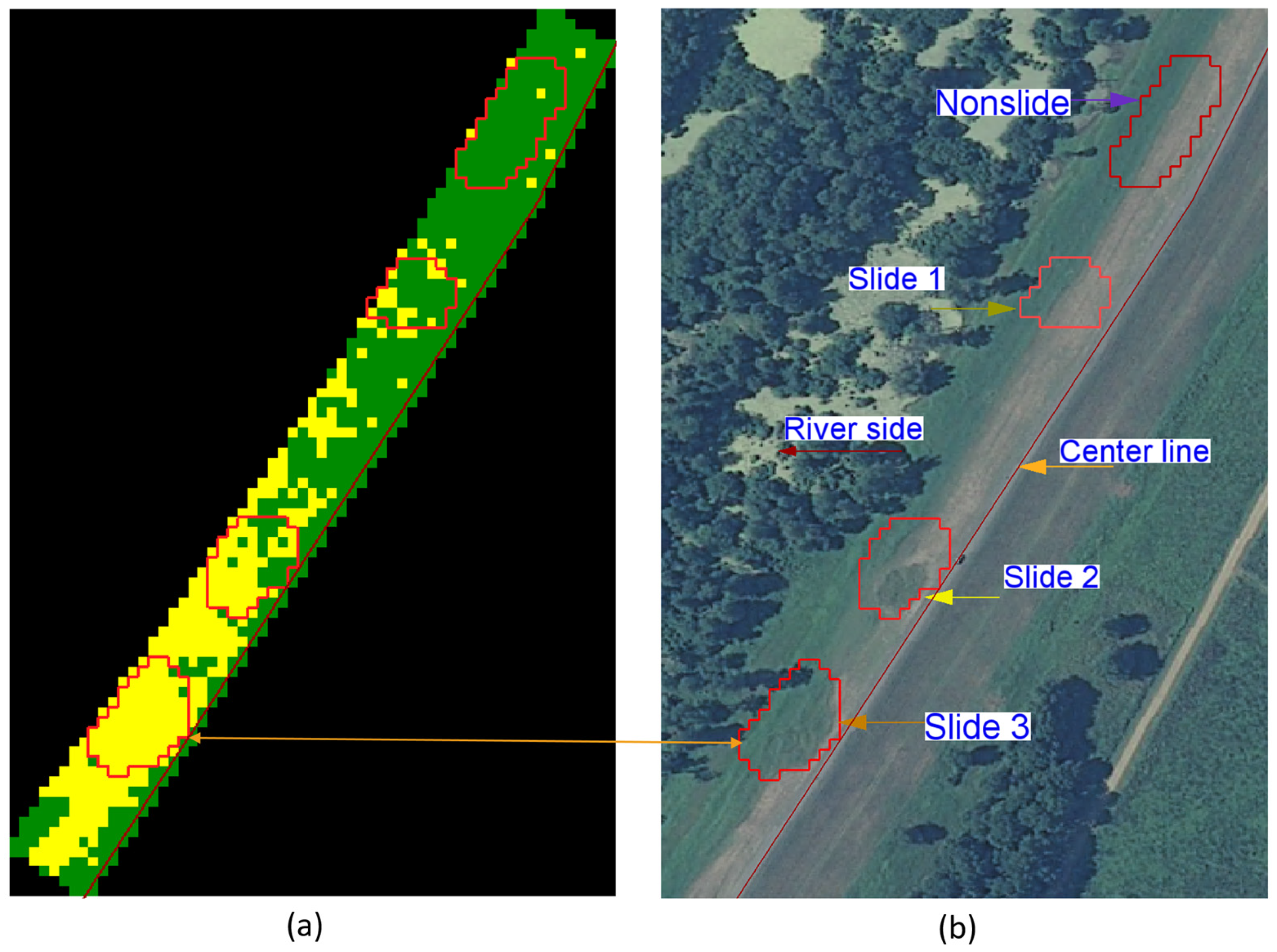
| Slide Number | Length | Vert. Face | Dist. from Crown | Latitude North | Longitude West | Date Slide Appeared | Date Slide Repaired |
|---|---|---|---|---|---|---|---|
| 1 | 80’ | 2’ | 30’ | N 32-36’-37.7” | W 90-59’-42.3” | Oct. 2009 | Nov. 2009 |
| 2 | 120’ | 3’ | 15’ | N 32-36’-32.0” | W 90-59’-46.3” | Aug. 2008 | Nov. 2009 |
| 3 | 200’ | 8’ | 8’ | N 32-36’-29.1” | W 90-59’-48.0” | - | Sept. 2010 |
| Slide No. | From Levee Board (8 April 2011) | From Visual Aerial Photo Inspection | ||
|---|---|---|---|---|
| Date Slide Appeared | Date Slide Repaired | NAIP 2009 (May–Sep.) | NAIP 2010 (May–Sep.) | |
| 1 | Oct. 2009 | Nov. 2009 | Not Visible (July 25) | Repaired (June 22) |
| 2 | Aug. 2008 | Nov. 2009 | Unrepaired (July 25) | Repaired (June 22) |
| 3 | - | Sept. 2010 | Unrepaired (July 25) | Unrepaired (June 22) |
| Classification Method V/s. Accuracy (%) | Overall Accuracy = (132/162) 81% | ||||||||
|---|---|---|---|---|---|---|---|---|---|
| Ground Truth (Pixels) | Ground Truth (%) | ||||||||
| MD u/Euclidean | Class | slide3 | non-slide | Total | slide3 | non-slide | Total | Prod. Accu. (%) | User Accu. (%) |
| slide3 | 48 | 0 | 48 | 61 | 0 | 29 | 61 | 100 | |
| non-slide | 30 | 84 | 114 | 38 | 100 | 70 | 100 | 73 | |
| Total | 78 | 84 | 162 | 100 | 100 | 100 | |||
| MD u/Mahalanobis | Overall Accuracy = (146/162) 90% | ||||||||
| slide3 | 62 | 0 | 62 | 79 | 0 | 38 | 79 | 100 | |
| non-slide | 16 | 84 | 100 | 20 | 100 | 61 | 100 | 84 | |
| Total | 78 | 84 | 162 | 100 | 100 | 100 | |||
| SVM | Overall Accuracy = (158/162) 97% | ||||||||
| slide3 | 62 | 0 | 62 | 79 | 0 | 38 | 96 | 98 | |
| Non-slide | 16 | 84 | 100 | 20 | 100 | 61 | 98 | 96 | |
| Total | 78 | 84 | 162 | 100 | 100 | 100 | |||
| ML | Overall Accuracy = (159/162) 98% | ||||||||
| slide3 | 76 | 1 | 77 | 97 | 1 | 47 | 97 | 98 | |
| non-slide | 2 | 83 | 85 | 2 | 98 | 52 | 98 | 97 | |
| Total | 78 | 84 | 162 | 100 | 100 | 100 | |||
| Classification Method Vs. Accuracy (%) | Overall Accuracy | Slide Accuracy | Non-slide Accuracy | |
|---|---|---|---|---|
| MD | u/Euclidean | 81 | 61 | 100 |
| u/Mahalanobis | 90 | 79 | 100 | |
| SVM | 97 | 96 | 98 | |
| ML | 98 | 97 | 98 | |
© 2017 by the authors. Licensee MDPI, Basel, Switzerland. This article is an open access article distributed under the terms and conditions of the Creative Commons Attribution (CC BY) license (http://creativecommons.org/licenses/by/4.0/).
Share and Cite
Marapareddy, R.; Aanstoos, J.V.; Younan, N.H. Accuracy Analysis Comparison of Supervised Classification Methods for Anomaly Detection on Levees Using SAR Imagery. Electronics 2017, 6, 83. https://doi.org/10.3390/electronics6040083
Marapareddy R, Aanstoos JV, Younan NH. Accuracy Analysis Comparison of Supervised Classification Methods for Anomaly Detection on Levees Using SAR Imagery. Electronics. 2017; 6(4):83. https://doi.org/10.3390/electronics6040083
Chicago/Turabian StyleMarapareddy, Ramakalavathi, James V. Aanstoos, and Nicolas H. Younan. 2017. "Accuracy Analysis Comparison of Supervised Classification Methods for Anomaly Detection on Levees Using SAR Imagery" Electronics 6, no. 4: 83. https://doi.org/10.3390/electronics6040083





